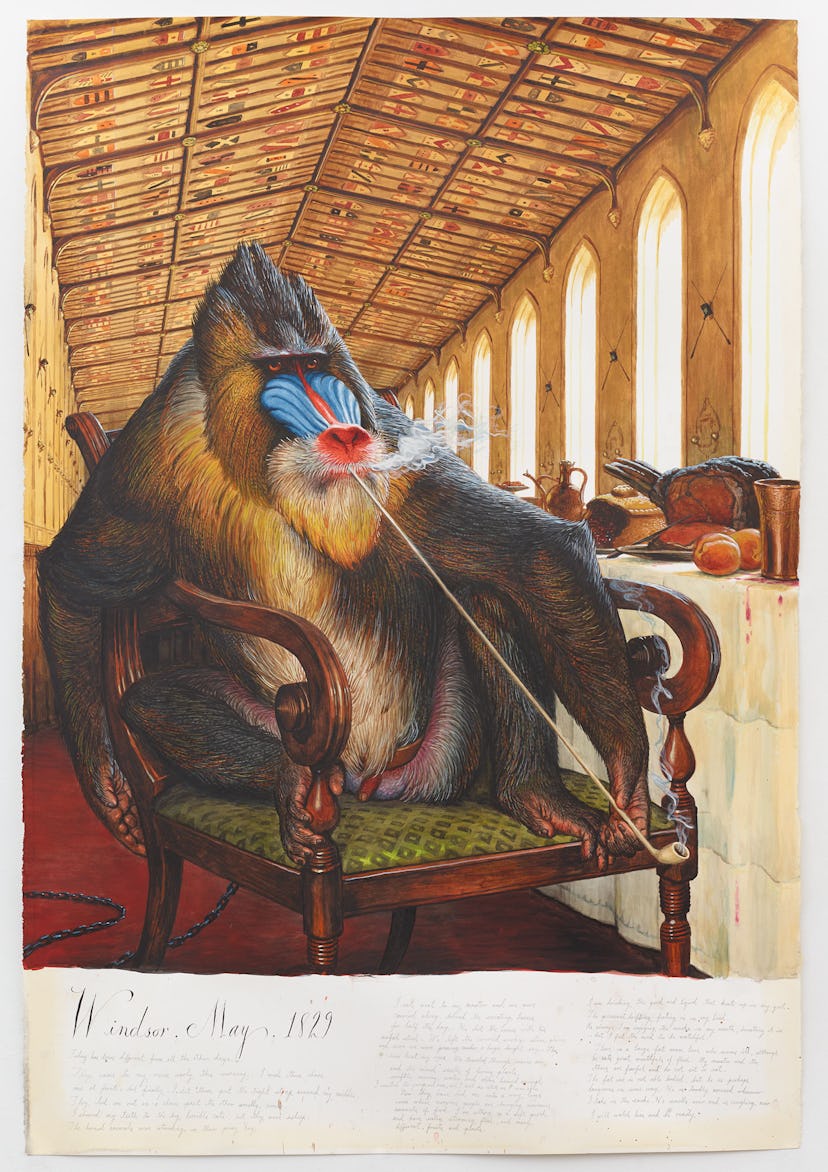Go Ape

Susie, a gorilla with a lustrous black coat, is crossing the Atlantic en route to New York. It’s 1929, so she is traveling by zeppelin. In a well-publicized spectacle, she will be the first female gorilla ever to set paw on U.S. soil—and she looks bewildered, or lost, or maybe simply resigned to a long life of entertaining strangers. This is the scene in one of Walton Ford’s latest watercolor paintings, The Graf Zeppelin (2014), which will be on view in the artist’s solo exhibition opening at New York’s Paul Kasmin Gallery on May 1.
Ford’s depiction of the plight (and flight) of Susie is not only notable for its incredible backstory and adept rendering of a gorilla’s inner life, but for the painting’s stillness. From Ford, a realist painter of wildlife who borrows from natural history illustrators like James Audubon, we expect vicious wolves and killer birds and scaly crocodiles, choking and biting and beheading one another. “My traditional mode of working is with action-packed narratives,” Ford, 54, admits. “But my last show got me interested in doing portraits.”
That would be a 2011 exhibition, also at Paul Kasmin, of enormous—i.e., “life” size—portraits of King Kong’s head in various states of fury and disappointment. “I wanted to expand on this idea of a good, simple portrait,” Ford says. “Animal activists anthropomorphize them in a way that allows you to understand their suffering. What I do is subtler. Susie, for example, is more numb than anything else—the kind of numbness that comes from too much sudden change.”
About a year and a half ago, Ford’s friend Robert Thurman—father of Uma, founder of Tibet House and very public Buddhist—suggested to Ford that the artist must have been reincarnated so that he could act as a medium for the animal kingdom. “I thought it was crazy nonsense—at first,” Ford says. “But then I thought, What if I just went ahead and acted as if that were actually the case? The idea is still absurd, and insanely hubristic. But it gave me the permission to make these paintings.”
Ford sells his paintings for millions of dollars to celebrity collectors like Daphne Guinness, Tom Ford, and Leonardo DiCaprio, but he has a prickly sense of humor about his status in the art world. “I don’t care about fine art,” he says, laughing. In fact, he has taken a half step further away by handwriting interior dialogue from the animals’ point of view directly onto several of the new paintings. The words can be artfully abstruse, but the format is not unlike that of a graphic novel (a medium he is planning to explore). “I was definitely inside the head of those animals,” Ford says. When he was making a painting of a mandrill named Happy Jerry who was brought from London to Windsor Palace in order to entertain King George IV, Ford recreated the day in his head: “So it’s six hours back and forth from London to Windsor; he would’ve had lunch with the king. Obviously, he wouldn’t stay overnight there. He would’ve gotten up early. They would’ve put a leather strap around his middle. How would you transport a mandrill? What would the ride feel like?” It sounds as though he is just getting going, but Ford cuts himself off. “I just thought if I could work through the process myself, then I might have actual insight into the mandrill,” he explains. “Otherwise, it’s just bullshit.”
Photos: Go Ape
“The Graf Zeppelin,” 2014 by Walton Ford. Courtesy of the artist and Paul Kasmin Gallery.
“Calvaire,” 2012 by Walton Ford. Courtesy of the artist and Paul Kasmin Gallery.
“The Tigress,” 2013 by Walton Ford. Courtesy of the artist and Paul Kasmin Gallery.
“Windsor, May 1829,” 2014 by Walton Ford. Courtesy of the artist and Paul Kasmin Gallery.
“Rhyndacus” by Walton Ford. Courtesy of the artist and Paul Kasmin Gallery.